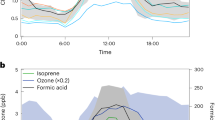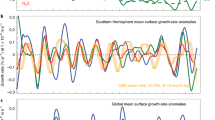Abstract
The gas-phase reaction between BrO and CIO has been proposed as a potentially fast and synergistic mechanism of stratospheric ozone destruction. Further, it has been advanced1 as a contributing factor to Antarctic springtime ozone column losses of ∼40% from 1960 to 19852,3 Both dynamical4 and chemical theories1,5–8 have been advanced to explain the formation of the Antarctic 'ozone hole'. A major uncertainty in these theories has been the rate constant and product distribution of the BrO + ClO reaction as a function of temperature. Here we report the first direct measurements of these parameters. We show that this reaction could, indeed, account for a large fraction of the springtime ozone depletion over Antarctica and provide a source of chlorine dioxide of sufficient magnitude to explain the recent measurements of this species in the Antarctic stratosphere, provided that the stratosphere contains a sufficient quantity of bromine (∼20 p.p.t.v.).
This is a preview of subscription content, access via your institution
Access options
Subscribe to this journal
Receive 51 print issues and online access
$199.00 per year
only $3.90 per issue
Buy this article
- Purchase on Springer Link
- Instant access to full article PDF
Prices may be subject to local taxes which are calculated during checkout
Similar content being viewed by others
Author information
Authors and Affiliations
Author notes
To whom correspondence should be addressed.
- Alan J. Hills
Rights and permissions
About this article
Cite this article
Hills, A., Cicerone, R., Calvert, J. et al. Kinetics of the BrO + ClO reaction and implications for stratospheric ozone. Nature 328, 405–408 (1987). https://doi.org/10.1038/328405a0
Received:
Accepted:
Issue Date:
DOI: https://doi.org/10.1038/328405a0
This article is cited by
-
High resolution spectral features of a series of aromatic hydrocarbons and BrO: Potential interferences in atmospheric OH-measurements
Journal of Atmospheric Chemistry (1991)
-
Measurements of atmospheric BrOx radicals in the tropical and mid-latitude atmosphere
Nature (1988)
-
Formation of the Antarctic ozone hole by the CIO dimer mechanism
Nature (1988)
-
The hole in the ozone layer ? a much discussed phenomenon of this decade
Naturwissenschaften (1988)
-
Antarctic chemistry to blame
Nature (1987)
Comments
By submitting a comment you agree to abide by our Terms and Community Guidelines. If you find something abusive or that does not comply with our terms or guidelines please flag it as inappropriate.



